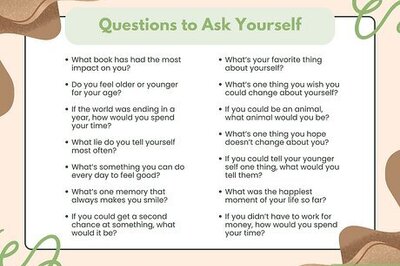
views
What is a haint?
Haints are restless spirits who haven’t crossed over after death. Haints are a type of ghost from Gullah Geechee folklore and are stuck between the world of the living and the world of the dead. They’re typically malicious and are believed to haunt the home by entering through doors and windows and causing all types of chaos. That chaos can range greatly, from destroying furniture and opening drawers to stealing or harming naughty children and other individuals. Appearance: Most of the time, haints are invisible. When they do appear, they’re said to resemble regular people, but with a more pale, ghostly look to them. Most people think haints are evil, but some claim they simply reveal truths you aren’t ready to see or confront. Haints also roam around areas they were associated with during life, like battlefields or workplaces. The Gullah Geechee people are a community of African Americans that spans across North Carolina, South Carolina, Florida, and Georgia. They preserved African traditions when they were brought to America as slaves. Are haints and ghosts the same thing? A haint is a specific type of malicious ghost that likes to cause trouble around homes. All haints are ghosts, but not all ghosts are haints!
Origin of Haints
Haints originate from Gullah Geechee culture. The Gullah Geechee community is an African American community that spans across the coastal areas of North Carolina, South Carolina, Georgia, and Florida. They have preserved many African traditions since they were initially brought over as enslaved people, and believed in malevolent spirits called haints. There isn’t much known about how haints came to be within Gullah Geechee culture, as the belief in spirits goes back to ancient times.
Haints are a part of hoodoo, an African American practice of spirituality. Hoodoo combines West African folk traditions, European folklore and magic, and Native American practices. Rather than a religion, hoodoo is considered a set of magical practices that are employed to protect one from spirits, encourage healing, and influence various outcomes in one’s life. Haints are spiritual figures in hoodoo, being wrapped in with African American folk traditions.
How to Spot Haints
Quiet your mind, concentrate, and feel for shifts in the air. When you suspect that there’s a haint in your home, feel for shifts in the air, like sudden temperature changes or wind coming from nowhere, or breath being breathed on your face. Some haints exist to take your breath, and feeling these things can be a sign that they’re present.
Pay attention to ghostly sounds with no source and misplaced items. When you suspect that there’s a haint in your home but don’t feel any immediate signs, like air shifts or random breaths, search for other signs of a haunting, like falling items, misplaced furniture, and doors opening and closing out of nowhere. If they happen consistently without any natural explanation, you may have a haint on your hands.
Visit someone who is clairvoyant for more guidance. Someone who is gifted with clairvoyance can see more than what meets the average person’s eye, like spirits, ghosts, and haints. So, if you suspect that you have a haint haunting, visit a clairvoyant person, like someone you’re close to, a psychic medium, or someone who has prior experience with spirits, and ask them to give you a reading. Depending on who you go to, they may ask a few questions or simply read your palms to determine whether or not you’re haunted by a haint.
How to Ward Off Haints
Paint the ceiling of your porch and window frames haint blue. Haint blue is a blue-green shade that is used to catch haints before they enter the home, particularly in the Southern region of Charleston, South Carolina. The shade is said to confuse haints, who believe they are looking at the sky or an ocean and bypass the home entirely. To add some extra fortification, paint your doors and shutters haint blue, too.
Put bottles around the branches of your trees. Originally from West Africa by way of the Gullah people, the tradition of making “bottle trees” by placing bottles around the branches of trees is used to trap haints and evil spirits. According to Gullah folklore, haints are attracted to the shining clink of the bottles, and once they enter, they are trapped until sunrise, when the sunshine can destroy them. If you want to ensure that the haints are trapped in the bottle, put lard in the bottleneck. Alternatively, cover the bottle and drop it in the sea (or your nearest bottle of water).
Line your walls with newspaper. According to Gullah legend, haints get distracted by repetitive tasks, like counting coins and broom bristles, or reading newspapers. So, whether you’re haunted by a haint already or simply trying to protect your home, find some old newspapers and line your wall with them to distract the haint overnight. They won’t be able to finish reading the papers by the time the sun rises.
Put a broom or grains of rice at your door. Like the newspaper trick, this method distracts the haint by presenting broom bristles or grains of rice for it to count. According to legend, by the time the haint is done counting all of the bristles of the broom, grains of rice, or whatever else you put by the door for protection, it will be burned by the rising sun.
Clean your house and burn incense in every room. According to legend, burning sage and cleaning your house afterward cleanses it of haints. Start by burning sage in each room, then mop all of your floors with a mixture of pine and camphor. After mopping the floors, sprinkle salt across the doors, windows, and corners of your house.
Hang a mirror by the door. Hanging mirrors by the door is thought to ward off evil spirits by trapping and distracting them in their own gaze. Although this method doesn’t ensure that the haint won’t enter your home, it gives you a good shot at keeping your home protected until you can enact more permanent methods of protection, like bottle trees or haint blue porches.
Haints in Pop Culture
Haints were popularized by the 2025 horror film, Sinners. The 2025 horror film, Sinners, discusses many aspects of African American spirituality and hoodoo, from rootwork and ancestral connections to mojo bags and haints. In the film, Annie (played by Wunmi Mosaku) suspects the monsters that invade the juke joint to be haints. But she finds out that they’re actually vampires, thanks to their desire for blood and their pale, sickly appearances. In the film, Annie’s character practices hoodoo and voodoo, providing Smoke (played by Michael B. Jordan) with a mojo bag and protecting her home with haint blue.
Before Sinners, Haints appeared in Harper Lee’s To Kill a Mockingbird. Haints are briefly referred to in To Kill a Mockingbird when Jem tells Scout that “a hain’t lives there” as they pass Arthur “Boo” Radley’s home. In the novel, Radley is painted as a monster by the town and has a sickly, thin appearance with grey, seemingly blinded eyes, causing the children to believe he’s a haint.
Haint blue has been written about in various newspapers and articles. The tradition of South Carolinians painting their porches, window frames, and other parts of their houses haint blue has been reported on by a vast number of publications, from Apartment Therapy and Southern Living to The Charleston Post Courier and Today. The publications discuss the historical value of the tradition and where to find historic homes with haint blue porches, among other things.
More Southern Folklore
Boo Hag A boo hag is a type of spirit that drains your energy and life force, like vampires. What differentiates them from vampires is the fact that they drain your life force by drawing your breath from you while you sleep, while vampires drink your blood. They are skinless, red creatures that are said to keep you alive just enough so they can continue to steal your breath. Their breath siphoning is said to induce a sleep full of dreams and leave you exhausted in the morning, even if you got a full night’s rest. According to legend, if you struggle against a boo hag, they may steal your skin.
Holler Magic Also known as Appalachian folk magic and granny magic, holler magic is a set of spiritual beliefs that hail from European folk magic, combining it with Native American and African folk influences (albeit less than hoodoo) to inform their traditions of healing and harming. It is practiced by those who live in the Appalachian region. Holler magic is mainly practiced by the grannies (older women who served as midwives, healers, and teachers of ancestral knowledge).
Two-Toed Tom According to legend, Two-Toed Tom is a terrorizing alligator who once roamed the swamps of Florida and Alabama. Also known as Two-Toe or Red-Eye, the alligator sported red eyes, a massive 14-foot height, and lost all but two toes after one of its feet was caught in a steel trap. The monster reportedly ate livestock and terrorized humans for over two decades.
Flying Africans Flying Africans are legends from the Gullah Geechee mythology that reportedly flew back to Africa by jumping overboard in suicide attempts to avoid being enslaved. The legend goes back to 1803, when the Igbo people walked into the water at Igbo Landing to avoid being enslaved. Some believe that they actually flew, while others take the flight as a metaphor for resistance.




















Comments
0 comment